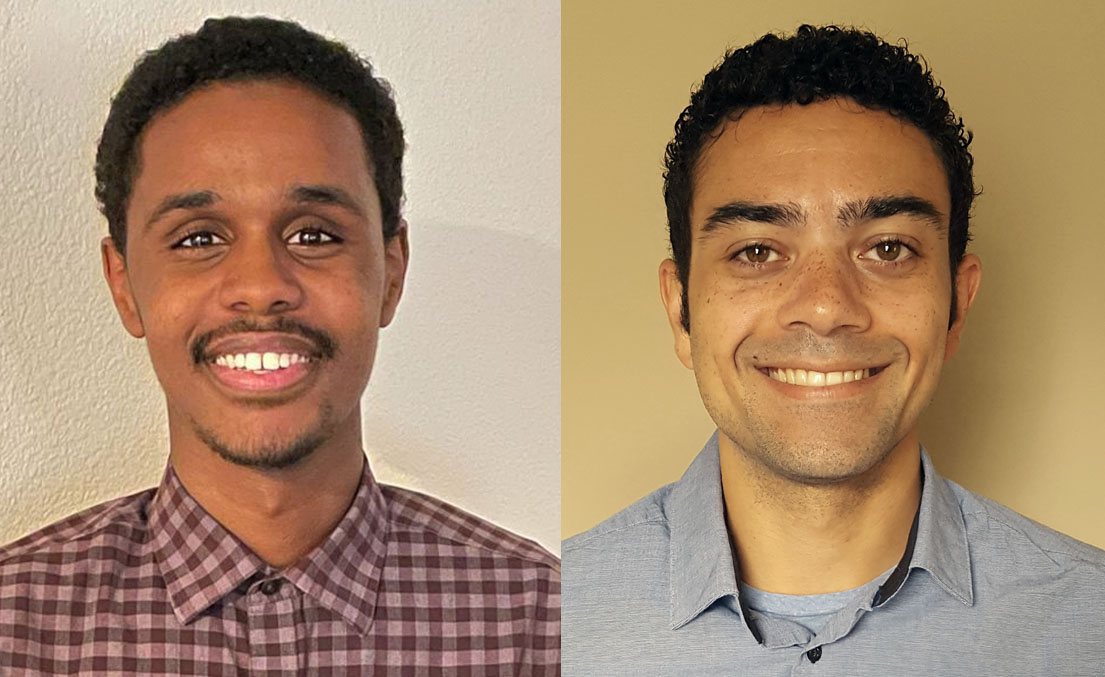A conversation between GEM fellows past and present

In June, WD&E spoke with current GEM fellow Liban Hussein (left) and Staff Scientist (GEM alum) Dr. Micah Folsom (right) about their experiences with the National GEM Consortium. Berkeley Lab became an employer member of the Consortium in 2017; since then, 10 fellows have been placed throughout Berkeley Lab. Hussein and Folsom’s answers have been edited for brevity and clarity.
Can you tell me a little about yourself?
Hussein: I’m a recent graduate from the University of Washington. I completed my bachelor’s in 2020 in electrical engineering. I’m currently on a gap year interning with Berkeley Lab and then I begin a PhD in the fall at the University of Washington in electrical engineering. My parents are originally from East Africa. At the Lab, I’m working with Dr. Carl Grace and Dario Gnani. His team is building integrated circuits for neutrino detection.
Folsom: I’m from San Diego originally. I started at Berkeley in nuclear engineering and then did two years of research after finishing my bachelor’s [degree]. After that, I applied and got into the University of Tennessee in Knoxville. For the GEM Fellowship, I conducted research at Oak Ridge National Laboratory. I spent my required GEM summer internship at Pacific Northwest National Laboratory. On my way to graduate school, I did a summer internship at the IAEA (International Atomic Energy Agency) in Vienna, Austria. I finished my PhD in nuclear engineering about a year ago in April 2020. At the Lab, I work on radiation detector systems.
What drew you towards a career in research?
Hussein: When I was in fifth grade, there was this after-school electronics club for low-income students. They had bought out a bunch of textbooks. We worked on hands-on projects like audio amplifiers and radio receivers. That’s what sparked the interest in science. From there, I did some more hobbyist projects and some community work.
Folsom: My dad is an on-air DJ and he was always building radios. My older brother and I particularly got really into computers. At about nine years old, I was writing C code for video games. Later, I applied to undergrad in electrical engineering and computer science. Then I switched into nuclear after taking a seminar that taught us all the different applications of nuclear technology because it seemed really interesting and interdisciplinary.
Can you tell me about GEM?
Hussein: GEM is a highly prestigious organization that seeks to increase the number of minorities and underrepresented individuals at the graduate level. By applying to a graduate program and detailing your experience in your GEM application, if selected, you’re paired with an industry or lab sponsor for a summer internship(s) and provided with a fellowship to aid in the costs as a student.
Folsom: GEM is a really fantastic networking tool. It’s a lot of people that are really looking out for your best interests. There’s also workshops that [GEM] does all over the country that explicitly are geared towards training undergraduates and encouraging them to go to graduate school. GEM is a National Science Foundation program, so you’re getting really high-quality candidates. They’ve basically presented the best of the best students that are pursuing research in the country.
How do GEM fellows benefit from their time at Berkeley Lab?
Hussein: At a government facility, you’re really given the opportunity to hone skills and bring your own unique experiences.The staff have been super willing and super helpful. A minority group would be able to immensely benefit from working here, whether they’re working to develop certain skills and have access to those tools or developing skills and publications and writing.
Why is GEM an important program for Berkeley Lab?
Hussein: There’s a famous saying in Somalia where my family is originally from: diversity is a mercy. When you’re able to get more diversity, you’re able to get different opinions and experiences. In doing so, more people, especially those from underrepresented backgrounds, are able to positively contribute to their communities, work environments, and schools.
Folsom: Diversity of perspectives and experiences is really important for the scientific mission more broadly. There’s almost a moral obligation to correct the wrongs of history. You know, we need to be bringing more underrepresented scientists because they were excluded historically and intentionally.
Have you thought about reaching that next generation of scientists?
Hussein: In high school, I tutored East African immigrants, particularly from the Somali community. We did electronics projects for them as well. I’m also working with a registered student organization (RSO) at the UW known as A Vision for Electronic Literacy and Access (AVELA) made by minority students for minority students. We teach STEM classes to students from underrepresented backgrounds ranging from K-14 and are continuing to grow and form partnerships within schools in the greater Seattle area.
Folsom: I’ve been getting into a lot of educational outreach. I think one of the first things I did at Berkeley Lab was Nuclear Science Day. We taught boy scouts and girl scouts about radiation and nuclear science.
Final thoughts?
Hussein: At the end of the day, ask yourself how you can bring people into the story that have the skills, but don’t really have the opportunity to showcase those skills.
Folsom: GEM only works if research scientists hire underrepresented students. It’s up to us – career scientists – to take the initiative and put our money where it matters.
The National GEM Consortium can be a way to bring more interns into the story of science. For more information about GEM at Berkeley Lab, please visit the GEM program webpage.
–Ingrid Ockert, Marketing Communications Coordinator

